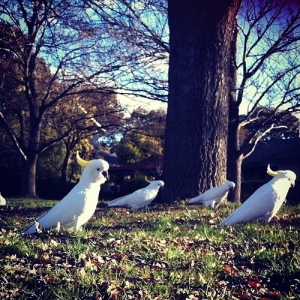(module 5) in #hyperlibmooc land
I said a very quick hello here in the spirit of transparency, but don’t seem to be able to embed YouTube into this blog, so will link to it instead…Kate in #hyperlibmooc land
* 14 Oct see below- now successfully embedded thanks to Peta 🙂
I sound so Australian which is always interesting as my parents are from England, and I am the first born in my family, although that was a long time ago….and I have such an Australian drawl…. 🙂
It’s always interesting meeting someone IRL when you have been interacting with them online. At the beginning of this year I met someone IRL that I had known for a while. I knew what F looked like, but had totally not thought about how she sounded…her voice was gentle and quite mellifluous! So the YouTube will give you some idea of my voice….if you were ever interested!
Radical transparency…
Love the idea of writing initials on a post, whether it be our Library blog, Facebook or twitter accounts – so that users, patrons can tell who the human is behind the post. Not so much of a problem at the moment as I do 99.999% of all of this, but that will change very soon I hope. I have noticed other organisations doing this, for example the CSIRO Twitter feed. CSIRO is the Australian commonwealth scientific research organisation. The people posting put their initials after each post, and it does humanise the posts, makes those posting more transparent, and makes the organisation less faceless. I vaguely know one of the people posting so always look out for their contributions. This is something that I intend to implement within my (soon to be formed) social media team. I will do my part to bring transparency to my organisation.
“…the idea that if you don’t talk about yourself, other people will” (Thompson, 2007) is always something to remember. It doesn’t mean that they will, but that they might. The issues around privacy and transparency are something that cannot just be sorted or fixed once but are an ongoing consideration. When I think of privacy I often think of my privacy settings on Facebook. There are quite frequent changes to the privacy settings in Facebook, and only this week there have been more – ‘How to lock down Facebook privacy now that old posts are searchable‘. Aspects of privacy are more personal and depend on the individual. Choice and education around privacy issues are important. Making informed decisions.
I did have a situation earlier this year when a manager rang me about my personal bog. “Did I realise that someone on another campus had read my blog and that I had been critical of management?” The interesting thing is that the middle management that I was being critical about was the very same manager who rang me! I was not embarrassed. I did not take the post down. I was very aware when I wrote the post that it would be online for anyone to see. I didn’t know that many of my colleagues regularly read my blog. I was very transparent. I simply stated that it was my blog, my opinion and that I posted knowing this. I was not in breach of any policy. Nothing else ever happened. I wasn’t entirely sure why the manager rang me. But a cautionary tale in being aware of what you say online, and how it can be viewed by others. [The post is ‘in another life‘ if you want to read the offending lines].
I think that in terms of transparency it is important to read widely other organisational and personal blogs, Facebook pages and articles. Being transparent is still very hard for some people and organisations, and leading the way is important. Sometimes it can be useful to ask – “what is the worst possible thing that can happen by…” and often the answer is that people will see the organisation as human, as something they want to interact with, question, engage with?
I took this photo a few weeks back in the street around the corner coming home from a walk. Sulphur-crested cockatoos are common where I live. They are quite raucous and I call them hooligans. They love to eat rubber off street lights and are very loud. They live in quite large groups and screech when flying!
Bibliography:
Anderson, C. (2006, November 26). In praise of radical transparency [Web log post]. The Long Tail. Retrieved from http://www.longtail.com/the_long_tail/2006/11/in_praise_of_ra.html
Boyd, D. (2010, August 23). Social steganography: Learning to hide in plain sight [Web log post]. DML central. Retrieved from http://dmlcentral.net/blog/danah-boyd/social-steganography-learning-hide-plain-sight
boyd, d. (2010). SXSW 2010: Privacy and Publicity. Retrieved from http://www.danah.org/papers/talks/2010/SXSW2010.html
Casey, M., & Stephens, M. (2007, April). The transparent library: Introducing the Michaels. Library Journal, 132(6), 30. Retrieved from http://lj.libraryjournal.com/2007/04/ljarchives/the-transparent-library-introducing-the-michaels/
Casey, M., & Stephens, M. (2007, December). A road map to transparency. Library Journal, 132(20), 37. Retrieved from http://tametheweb.com/2007/12/15/a-road-map-to-transparency/
Casey, M., & Stephens, M. (2008, November). Six signposts on the way. Library Journal, 133(19), 21. Retrieved from http://tametheweb.com/2008/11/15/six-signposts-on-the-way/
Casey, M., & Stephens, M. (2008, November). Six signposts on the way. Library Journal, 133(20), 32. Retrieved from http://tametheweb.com/2008/12/01/six-more-signposts/
Thompson, C. (2007, March). The see-through CEO. Wired Magazine Online (Issue 15.04). Retrieved from http://www.wired.com/wired/archive/15.04/wired40_ceo.html
Filed under: Module 5 | 2 Comments
Tags: blogging, online, privacy, transparency




I know what you sound like!
It turns out that all I had to do to get a youtube clip embedded was just paste the URL on a single line all by itself.
so simple I didn’t try that!!! thanks Peta 🙂